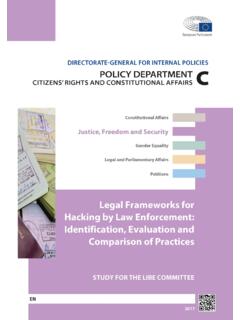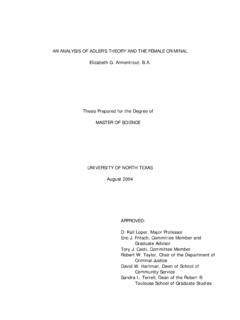Transcription of RADIOTELEPHONY COMMUNICATIONS 1 HANDBOOK
1 1 RADIOTELEPHONY COMMUNICATIONS 1 HANDBOOK Compiled by Ivana Franceti according to the EUROCONTROL Specification for the ATCO Common Core Content Initial Training Subject Subject abbreviation: AIR TRAFFIC MANAGEMENT ATM (Modular Training) Subject: RADIOTELEPHONY COMMUNICATIONS 1 (Integrated Training) Date: 2013-05-06 UNIVERSITY OF ZAGREB FACULTY OF TRANSPORT AND TRAFFIC SCIENCES HUSK CROATIAN AIR TRAFFIC CONTROL TRAINING CENTER ZUK Borongaj, 10000 Zagreb 2 1 CONTENTS 1 CONTENTS .. 2 2 RTF GENERAL OPERATING PROCEDURES .. 4 TRANSMITTING technique .. 4 TRANSMISSION OF LETTERS .. 4 TRANSMISSION OF NUMBERS .. 6 EXCEPTIONS TO NUMBERS .. 7 TRANSMISSION OF TIME.
2 8 CALL SIGNS .. 8 AERONAUTICAL STATIONS .. 8 CALL SIGNS AIRCRAFT .. 9 CATEGORIES OF MESSAGES AND ORDER OF PRIORITY .. 10 3 ESTABLISHMENT AND CONTINUATION OF communication .. 12 INITIAL CALL .. 12 MULTIPLE CALL .. 12 GENERAL CALL .. 13 ACKNOWLEDGEMENT OF MESSAGE RECEIPT .. 13 4 STANDARD WORDS AND PHRASES .. 14 5 READ BACK REQUIREMENTS .. 17 6 TEST PROCEDURES - RADIO CHECK AND READABILITY SCALE .. 19 7 Q CODES .. 21 8 METEOROLOGICAL INFORMATION .. 22 WAKE VORTEX SEPARATION .. 23 BRAKING ACTION .. 23 ESSENTIAL INFORAMTION ON AERODROME CONDITIONS .. 24 AMOUNT OF WATER ON THE RUNWAY .. 24 SKY COVERING IN OKTAS .. 24 WEATHER INFORMATION .. 25 AUTOMATIC TERMINAL INFORMATION SERVICE (ATIS).
3 25 VOICE WEATHER BROADCAST (VOLMET) .. 26 9 ORDER OF INSTRUCTIONS IN AERODROME CONTROL ENVIRONMENT .. 27 DEPARTURE INFORMATION .. 28 ENGINE STARTING PROCEDURES .. 30 PUSH-BACK/POWER-BACK PROCEDURES .. 32 ATC CLEARANCE .. 34 IFR .. 34 VFR .. 35 TAXI PROCEDURES .. 39 LINE UP .. 42 CONDITIONAL LINE-UP CLEARANCE .. 44 TAKE OFF CLEARANCE .. 44 CANCELLATION OF TAKE-OFF CLEARANCE AT THE HOLDING POINT 47 REJECTING THE TAKE OFF CLEARANCE DURING THE TAKE OFF RUN 47 REPORTING AIRBORNE .. 47 GO AROUND .. 49 LOW APPROACH .. 50 3 LOW PASS .. 50 TOUCH AND GO .. 51 FULL STOP LANDING .. 52 FLYING IN THE TRAFFIC CIRCUIT/PATTERN/ZONE .. 52 DELAYING ACTIONS .. 57 AERODROME CONTROL - TRAFFIC INFORMATION.
4 58 JOINING INSTRUCTIONS, FINAL APPROACH AND LANDING .. 59 4 2 RTF GENERAL OPERATING PROCEDURES Pilots and air traffic controllers communicate by using the RADIOTELEPHONY phraseology that consists of a set of standardized words and phrases approved for the RADIOTELEPHONY COMMUNICATIONS by ICAO in all routine aircraft situations. The communication is made possible due to their common and work-related topics, especially because the situations they find themselves in are highly predictable. Even if misunderstandings do occur, they are rather easily dealt with since both parties engaged in the conversation know what replies to expect from each other. Problems arise in non-routine and emergency situations, when pilots and controllers have to resort to plain English because the phraseology lacks the communicative means for effective communication in unpredictable situations such as on board medical emergencies, engine problems, fuel shortage or terrorism .
5 When both parties stick to the rules prescribed, problems in communication will rarely occur. First of all, good transmitting technique is needed. TRANSMITTING technique According to the ICAO Doc 9432 Manual of RADIOTELEPHONY the following transmitting techniques will assist in ensuring that transmitted speech is clearly and satisfactorily received: 1. Before transmitting, listen out on the frequency to be used to ensure that there will be no interference with a transmission from another station. 2. Be familiar with good microphone operating techniques. 3. Use a normal conversational tone, speak clearly and distinctly. 4. Maintain an even rate of speech not exceeding 100 words per minute.
6 When it is known that elements of the message will be written down by recipient, speak at a slightly slower rate. 5. Maintain the speaking volume at a constant level. 6. A slight pause before and after numbers will assist in making them easier to understand. 7. Avoid using hesitation sounds such as "er". 8. Depress the transmit switch fully before speaking and do not release it until the message is completed. This will ensure that the entire message is transmitted. 9. An irritating and potentially dangerous situation in RADIOTELEPHONY is a "stuck" microphone button. Operators should always ensure that the button is released after a transmission and the microphone placed in an appropriate place that will ensure that it will not inadvertently be switched on.
7 TRANSMISSION OF LETTERS The phonetic words shall be used when individual letters are required to be transmitted. 5 Some abbreviations have become unmistakable through common usage and are transmitted without using the phonetic word for each letter ILS, QNH, QFE. The following words are to be used when it is required to transmit individual letters. Table 1: THE RADIOTELEPHONY SPELLING ALPHABET (ICAO, Annex 10, Chapter 5) Letter Word Pronunciation Morse code A Alpha AL FAH . _ B Bravo BRAH VOH _ .. C Charlie CHAR LEE or SHAR LEE _ . _ . D Delta DELL TAH _ .. E Echo ECK OH . F Foxtrot FOKS TROT .. _ . G Golf GOLF _ _ . H Hotel HOH TELL .. I India IN DEE AH .. J Juliet JEW LEE ETT . _ _ _ K Kilo KEY LOH _.
8 _ L Lima LEE MAH . _ .. M Mike MIKE _ _ N November NO VEM BER _ . O Oscar OSS CAR _ _ _ P Papa PAH PAH . _ _ . Q Quebec KEH BECK _ _ . _ R Romeo ROW ME OH . _ . S Sierra SEE AIR RAH .. T Tango TANG GO _ U Uniform YOU NEE FORM or OONEE FORM .. _ V Victor VIK TAH .. _ W Whiskey WISS KEY . _ _ X X -ray ECKS RAY _ .. _ Y Yankee YANG KEY _ .. _ Z Zulu ZOO LOO _ _ .. The underlined syllables are to be emphasised when being pronounced. 6 TRANSMISSION OF NUMBERS All numbers except whole hundreds, whole thousands and combinations of thousands and whole hundreds shall be transmitted by pronouncing each digit separately. Whole hundreds and whole thousands shall be transmitted by pronouncing each digit in the number of hundreds or thousands followed by the word HUNDRED or TOUSAND as appropriate.
9 Combinations of thousands and whole hundreds shall be transmitted by pronouncing each digit in the number of thousand followed by the word TOUSAND and the number of hundreds followed by the word HUNDRED. The following examples illustrate the application of this procedure: Table 2: Pronunciation of numbers Numeral Pronounced as: 0 ZERO 1 WUN 2 TOO 3 TREE 4 FOWER 5 FIFE 6 SIX 7 SEVEN 8 AIT 9 NINER Hundred HUN DRED Thousand TOU SAND Decimal DAY SEE MAL Point POINT Table 3: Examples of pronunciation of numbers Number Pronounced as: 10 WUN ZE-RO 75 SEV-en FIFE 100 WUN HUN-dred 583 FIFE AIT TREE 2500 TOO TOU-SAND FIFE HUN-dred 5000 FIFE TOU-SAND 11000 WUN WUN TOU-SAND 18900 WUN AIT TOU-SAND NIN-er HUN-dred 25000 TOO FIFE TOU-SAND 38143 TREE AIT WUN FOW-er TREE Numbers containing a decimal point shall be transmitted with the decimal point in appropriate sequence being indicated by the word DECIMAL (in case of frequencies) or POINT (in all other cases).
10 A) indicated by the word DECIMAL 124,725 - one two fower decimal seven two five b) pronounced point in all situations except for frequencies distance miles - distance one one point fife miles Table 4: Reporting Mach number CTN123, report Mach number CTN123, (point seven fife) CTN123, reduce to (point seven two). 7 When the frequency of an aeronautical station is an intermediate 25 kHz the full figure will comprise 6 digits: 124,725 - ONE TWO FOWER DECIMAL SEVEN TWO FIFE Table 5: Pronunciation of numbers containing decimal point Number Transmitted as: 0,72 Mach MACH POINT SEVEN TWO 1,2 Mach MACH ONE POINT TWO 25,5 NM TWO FIFE POINT FIFE MILES ONE TWO ZERO DECIMAL THREE SEVEN FIVE ONE ONE EIGHT DECIMAL ZERO ONE ONE EIGHT DECIMAL ZERO ZERO FIVE ONE ONE EIGHT DECIMAL ZERO FIVE ZERO ONE ONE EIGHT DECIMAL ONE TWO FIVE ONE ONE EIGHT DECIMAL ONE FIVE ZERO 118,300 ONE ONE EIGHT DECIMAL TREE EXCEPTIONS TO NUMBERS Excepted from these above mentioned regulations are: 1.




